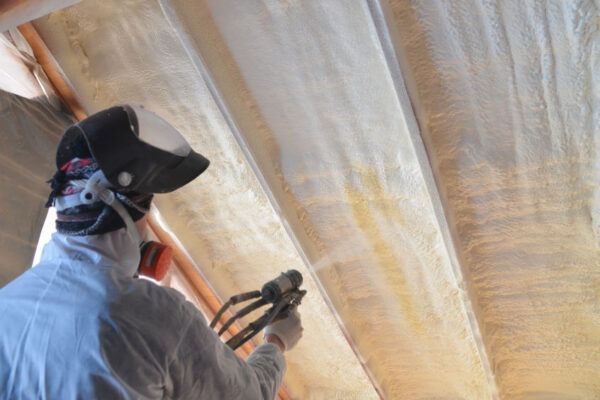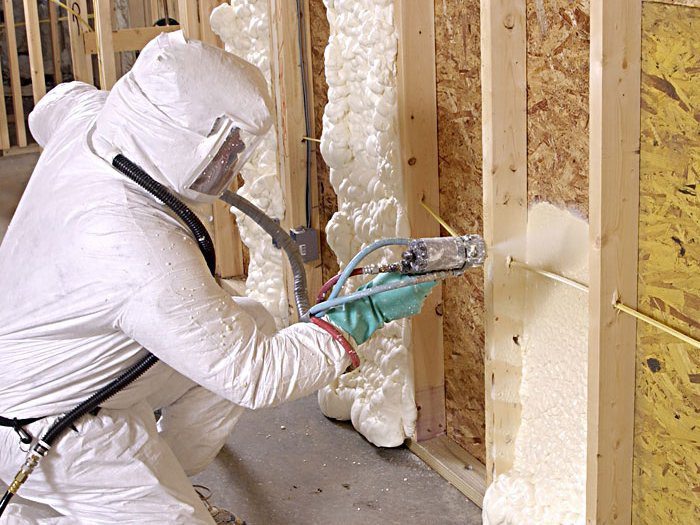Spray Foam: The Ultimate Service for Air Sealing and Insulation
Spray foam insulation has become a leading service for reliable air securing and thermal insulation, using an one-of-a-kind mix of properties that set it besides conventional methods. Its ability to broaden and load voids makes it especially efficient in protecting against air leak, which can dramatically impact energy performance. Comprehending the complete extent of its benefits, setup processes, and contrasts with various other insulation kinds is essential for making notified choices. As we discover these aspects, the ramifications for both new buildings and retrofits come to be significantly substantial. What aspects should affect your option?
What Is Spray Foam?
Spray foam is a flexible insulation product that incorporates the principles of air sealing and thermal resistance to boost power effectiveness in buildings. Made up primarily of polyurethane or various other similar substances, spray foam is used as a liquid that broadens upon call with surfaces, producing a strong, continual layer of insulation. This unique property permits it to fill up spaces, splits, and spaces that conventional insulation materials may overlook, providing a premium air seal.
There are two main kinds of spray foam: open-cell and closed-cell. Open-cell spray foam is lighter and much more versatile, using outstanding noise absorption and a reduced R-value per inch - Spray Foam. On the other hand, closed-cell spray foam is denser, providing a higher R-value, moisture resistance, and included architectural stability to building elements
The application procedure generally entails specialized equipment, ensuring a smooth application that sticks to various substrates, including concrete, timber, and steel. This adaptability makes spray foam ideal for both new buildings and retrofitting existing frameworks. Its ability to create an airtight barrier substantially adds to decreasing power intake and enhancing indoor air quality, thereby making it a preferred choice amongst builders and property owners alike.
Advantages of Spray Foam Insulation
Among the most significant benefits of spray foam insulation is its outstanding capacity to create a continual air obstacle, which successfully minimizes energy loss. Unlike standard insulation materials, spray foam increases to fill voids and splits, ensuring that air leak is drastically minimized. This characteristic not just enhances energy performance yet likewise leads to decrease energy costs over time.
Furthermore, spray foam insulation provides remarkable thermal resistance, adding to a much more steady indoor setting. Its high R-value per inch allows for reliable insulation in constrained spaces, making it excellent for attics, wall surfaces, and crawl rooms. Furthermore, the moisture-resistant residential or commercial properties of spray foam assistance prevent mold and mildew growth, promoting healthier living conditions.
An additional essential benefit of spray foam insulation is its sound-dampening qualities (Spray Foam). It properly minimizes sound transmission in between areas, developing a quieter and a lot more comfortable home atmosphere. The durability of spray foam additionally stands apart, as it does not droop or settle gradually, maintaining its performance throughout its life expectancy
How Spray Foam Works
Recognizing just how spray foam insulation functions is necessary for valuing its effectiveness in air sealing and thermal resistance. Spray foam insulation consists of 2 main parts: isocyanate and polyol resin. When these components are mixed, they undergo a chain reaction that causes the material to increase swiftly, creating a dense foam that fills dental caries, gaps, and fractures.
As the foam increases, it sticks to surfaces, developing a closed seal that dramatically minimizes air infiltration. This characteristic makes spray foam insulation very effective at stopping drafts and moisture infiltration, which can cause power loss and damage in time. In addition, the closed-cell variant of spray foam supplies superior thermal resistance due to its rigid framework, effectively reducing warm transfer.
The special residential properties of spray foam allow it to comply with uneven surfaces, guaranteeing thorough coverage and a seamless barrier. Consequently, spray foam insulation not only enhances power effectiveness but also adds to improved indoor air top quality by decreasing the buildup of allergens and pollutants. Inevitably, recognizing the technicians behind spray foam underscores its function as an exceptional option for insulation and air sealing in both household and industrial applications.
Setup Refine Introduction

Before installment, the room should be properly cleaned and prepped, making sure that surface areas are without particles, dirt, and moisture. Because contaminants can compromise bond and general performance, this step is critical. Once the area is prepared, the application entails mixing both elements of the spray foam, which broadens upon get in touch with and fills voids effectively.
Educated experts need to carry out the setup, utilizing specific tools to make sure uniform coverage and optimum thickness. Safety and security precautions, including putting on protective equipment and ensuring correct ventilation, are crucial throughout this process. After application, the foam generally treatments quickly, developing a strong barrier that improves energy efficiency.
Contrasting Spray Foam to Traditional Insulation
When examining insulation choices, spray foam insulation attracts attention in comparison to traditional products such as fiberglass and cellulose. Among the key benefits of spray foam is its premium air securing capacities. Unlike fiberglass and cellulose, which can permit air seepage, spray foam expands upon application, filling up gaps and spaces to produce a closed seal. This causes improved why not try these out energy effectiveness, as have a peek here much less warmed or cooled down air escapes the home, resulting in reduced utility bills.
Additionally, spray foam offers a higher R-value per inch than traditional insulation kinds, offering even more effective thermal resistance in a thinner profile. This particular is particularly beneficial precede with limited tooth cavity depth. Furthermore, spray foam is resistant to moisture and mold and mildew development, which can be a substantial problem with cellulose and fiberglass, specifically in damp environments.
Nonetheless, spray foam insulation typically lugs a greater ahead of time cost than its standard equivalents. Home owners have to evaluate this preliminary financial investment against long-lasting power financial savings and performance advantages. Eventually, while both insulation kinds serve their purpose, spray foam becomes a more advanced solution for contemporary insulation needs, particularly in regards to air sealing and thermal efficiency.

Verdict
In summary, spray foam insulation represents an extremely efficient solution for accomplishing ideal air sealing and thermal resistance. Its distinct residential or commercial properties, including wetness resistance and noise dampening, make it appropriate for different applications in both new buildings and retrofitting jobs (Spray Foam). Although the first costs might be higher contrasted to typical insulation products, the long-lasting advantages, such as significant energy financial savings and boosted indoor air high quality, justify the investment and highlight its value in contemporary structure practices.
Spray foam insulation has emerged as a leading option for see this page efficient air securing and thermal insulation, offering an one-of-a-kind combination of buildings that set it apart from typical techniques.Spray foam is a flexible insulation material that combines the concepts of air sealing and thermal resistance to improve power efficiency in buildings.When evaluating insulation alternatives, spray foam insulation stands out in contrast to conventional materials such as fiberglass and cellulose. Inevitably, while both insulation types offer their purpose, spray foam emerges as a more innovative service for modern-day insulation requirements, specifically in terms of air sealing and thermal performance.
In recap, spray foam insulation stands for a highly effective solution for achieving optimal air sealing and thermal resistance.